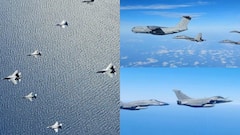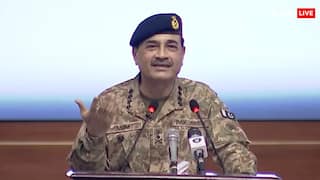Albanese Visit Marked Continuation Of Strategic India-Australia Bonding That Revived Under Morrison
From not inviting Australia to Malabar naval exercise in 2008 to welcoming PM Anthony Albanese on board INS Vikrant – India’s biggest warship – defence and strategic ties between Canberra and New Delhi have undergone a sea change.

New Delhi: Notwithstanding the internal political rivalry between them, Australian Prime Minister Anthony Albanese’s maiden visit to India marked continuation and thickening of the strategic ties between Canberra and New Delhi that were revived under former Australian PM Scott Morrison.
This week India and Australia ties went a step further with PM Albanese announcing that later this year Canberra will host the Malabar Naval Exercise – a joint drill by the navies of India, US, Japan and Australia.
Although the Malabar drill is multilateral in nature, it also is a reflection of deepening bilateral ties between New Delhi and Canberra.
In 2008, owing to pressure from China, India had stopped inviting Australia for the exercise. However, with increasing Chinese belligerence in the region, Australia was asked to rejoin in 2020 even as the Quad began to take shape at the same time after being kept on the backburner for decades.
ALSO READ | G20: India And Italy To Be Co-Chairs Of Global Partnership For Financial Inclusion For 3 Years
“In recognition of India and Australia’s robust maritime partnership, the Prime Ministers welcomed that Australia would host Exercise MALABAR in 2023 for the first time. The Prime Ministers agreed this would bolster interoperability between participating navies,” said the joint statement issued by India and Australia.
This is the first time Australia will be hosting the Malabar naval exercise, sending out strong signals to China. Australia, this year, is also hosting the Quad Leaders’ Summit.
Concluding his India visit early Saturday morning, PM Albanese left for the US to meet President Joe Biden and UK Prime Minister Rishi Sunak to discuss the progress of the AUKUS defence pact, under which Canberra is going to buy three to five US Virginia-class nuclear-powered submarines.
“I am proud of the deep and vibrant ties between our nations. My visit has strengthened the already close relationship that Australia enjoys with India, a key partner and good friend in the Indo-Pacific … I thank Prime Minister Modi for hosting my first official visit to India, and look forward to welcoming him to Australia for the Quad Leaders’ Summit mid-year,” Albanese said at the Annual India-Australia Leaders’ Summit.
PM Albanese, whose itinerary also included taking a selfie with Prime Minister Narendra Modi like his opponent and ex-PM Morrison, said that both countries will “strengthen defence and security partnership in support of both nations’ shared ambition for an open, stable and prosperous Indo-Pacific”.
Both sides will now be sharing defence intelligence with each other, especially in the maritime domain.
Addressing the media Friday, Modi said security cooperation is an “important pillar” of the India-Australia Comprehensive Strategic Partnership.
“Today, we had a detailed discussion on maritime security in the Indo-Pacific region, and increasing mutual defence and security cooperation. In the field of defence, we have made remarkable agreements in the last few years, including logistics support for each other's armed forces. There is also a regular and useful exchange of information between our security agencies, and we discussed further strengthening this,” he said.
Greater Defence Cooperation
In 2020, as the Covid pandemic raged around the world, Modi and Morrison upgraded bilateral ties to the level of ‘Comprehensive Strategic Partnership’ and signed the long-pending ‘Mutual Logistics Support’ agreement paving the way for greater defence cooperation.
According to the joint statement, “The Prime Ministers recognised the growing complexity and frequency of defence exercises and exchanges between the two countries and acknowledged the increasing interoperability between the respective forces through implementation of the India-Australia Mutual Logistics Support Arrangement.”
Albanese became the first head of state to visit India’s newest and biggest warship – INS Vikrant – where he also sat in the cockpit of LCA (Navy).
“The Prime Ministers agreed that, as a practical step, India and Australia may continue to explore conduct of aircraft deployments from each other’s territories to build operational familiarity and enhance maritime domain awareness,” the joint statement said.
Related Video
India@2047 Summit: Modi Calls for Innovation, Reforms, and National Resolve






































